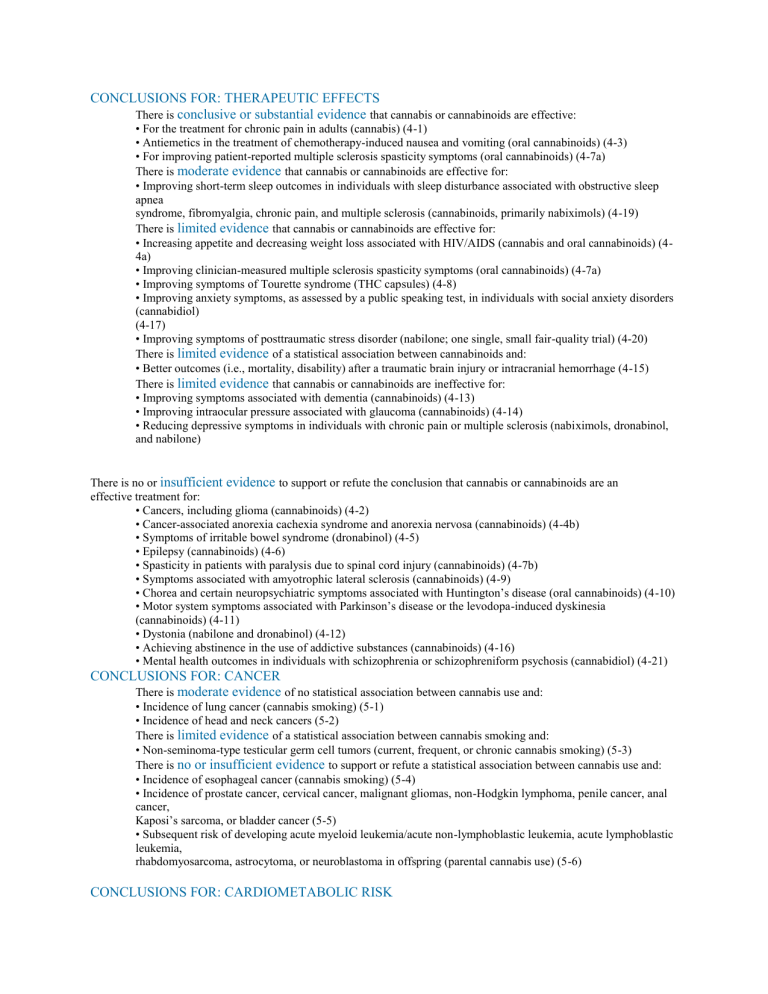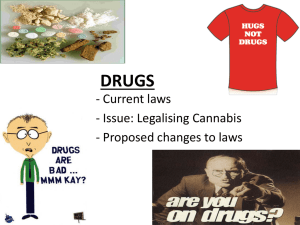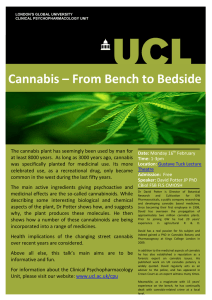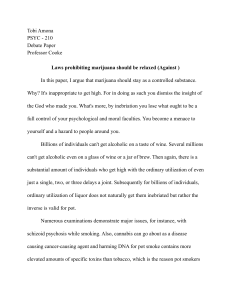
CONCLUSIONS FOR: THERAPEUTIC EFFECTS There is conclusive or substantial evidence that cannabis or cannabinoids are effective: • For the treatment for chronic pain in adults (cannabis) (4-1) • Antiemetics in the treatment of chemotherapy-induced nausea and vomiting (oral cannabinoids) (4-3) • For improving patient-reported multiple sclerosis spasticity symptoms (oral cannabinoids) (4-7a) There is moderate evidence that cannabis or cannabinoids are effective for: • Improving short-term sleep outcomes in individuals with sleep disturbance associated with obstructive sleep apnea syndrome, fibromyalgia, chronic pain, and multiple sclerosis (cannabinoids, primarily nabiximols) (4-19) There is limited evidence that cannabis or cannabinoids are effective for: • Increasing appetite and decreasing weight loss associated with HIV/AIDS (cannabis and oral cannabinoids) (44a) • Improving clinician-measured multiple sclerosis spasticity symptoms (oral cannabinoids) (4-7a) • Improving symptoms of Tourette syndrome (THC capsules) (4-8) • Improving anxiety symptoms, as assessed by a public speaking test, in individuals with social anxiety disorders (cannabidiol) (4-17) • Improving symptoms of posttraumatic stress disorder (nabilone; one single, small fair-quality trial) (4-20) There is limited evidence of a statistical association between cannabinoids and: • Better outcomes (i.e., mortality, disability) after a traumatic brain injury or intracranial hemorrhage (4-15) There is limited evidence that cannabis or cannabinoids are ineffective for: • Improving symptoms associated with dementia (cannabinoids) (4-13) • Improving intraocular pressure associated with glaucoma (cannabinoids) (4-14) • Reducing depressive symptoms in individuals with chronic pain or multiple sclerosis (nabiximols, dronabinol, and nabilone) THE CURRENT STATE OF EVIDENCE AND RECOMMENDATIONS FOR RESEARCH The REPORT There is no or insufficient evidence to support or refute the conclusion that cannabis or cannabinoids are an effective treatment for: • Cancers, including glioma (cannabinoids) (4-2) • Cancer-associated anorexia cachexia syndrome and anorexia nervosa (cannabinoids) (4-4b) • Symptoms of irritable bowel syndrome (dronabinol) (4-5) • Epilepsy (cannabinoids) (4-6) • Spasticity in patients with paralysis due to spinal cord injury (cannabinoids) (4-7b) • Symptoms associated with amyotrophic lateral sclerosis (cannabinoids) (4-9) • Chorea and certain neuropsychiatric symptoms associated with Huntington’s disease (oral cannabinoids) (4-10) • Motor system symptoms associated with Parkinson’s disease or the levodopa-induced dyskinesia (cannabinoids) (4-11) • Dystonia (nabilone and dronabinol) (4-12) • Achieving abstinence in the use of addictive substances (cannabinoids) (4-16) • Mental health outcomes in individuals with schizophrenia or schizophreniform psychosis (cannabidiol) (4-21) CONCLUSIONS FOR: CANCER There is moderate evidence of no statistical association between cannabis use and: • Incidence of lung cancer (cannabis smoking) (5-1) • Incidence of head and neck cancers (5-2) There is limited evidence of a statistical association between cannabis smoking and: • Non-seminoma-type testicular germ cell tumors (current, frequent, or chronic cannabis smoking) (5-3) There is no or insufficient evidence to support or refute a statistical association between cannabis use and: • Incidence of esophageal cancer (cannabis smoking) (5-4) • Incidence of prostate cancer, cervical cancer, malignant gliomas, non-Hodgkin lymphoma, penile cancer, anal cancer, Kaposi’s sarcoma, or bladder cancer (5-5) • Subsequent risk of developing acute myeloid leukemia/acute non-lymphoblastic leukemia, acute lymphoblastic leukemia, rhabdomyosarcoma, astrocytoma, or neuroblastoma in offspring (parental cannabis use) (5-6) CONCLUSIONS FOR: CARDIOMETABOLIC RISK There is limited evidence of a statistical association between cannabis use and: • The triggering of acute myocardial infarction (cannabis smoking) (6-1a) • Ischemic stroke or subarachnoid hemorrhage (6-2) • Decreased risk of metabolic syndrome and diabetes (6-3a) • Increased risk of prediabetes (6-3b) There is no evidence to support or refute a statistical association between chronic effects of cannabis use and: • The increased risk of acute myocardial infarction (6-1b) CONCLUSIONS FOR: RESPIRATORY DISEASE There is substantial evidence of a statistical association between cannabis smoking and: • Worse respiratory symptoms and more frequent chronic bronchitis episodes (long-term cannabis smoking) (73a) • There is moderate evidence of a statistical association between cannabis smoking and: • Improved airway dynamics with acute use, but not with chronic use (7-1a) • Higher forced vital capacity (FVC) (7-1b) There is moderate evidence of a statistical association between the cessation of cannabis smoking and: • Improvements in respiratory symptoms (7-3b) There is limited evidence of a statistical association between cannabis smoking and: • An increased risk of developing chronic obstructive pulmonary disease (COPD) when controlled for tobacco use (occasional cannabis smoking) (7-2a) CONCLUSIONS FOR: IMMUNITY There is limited evidence of a statistical association between cannabis smoking and: • A decrease in the production of several inflammatory cytokines in healthy individuals (8-1a) There is limited evidence of no statistical association between cannabis use and: • The progression of liver fibrosis or hepatic disease in individuals with viral Hepatitis C (HCV) (daily cannabis use) (8-3) There is no or insufficient evidence to support or refute a statistical association between cannabis use and: • Other adverse immune cell responses in healthy individuals (cannabis smoking) (8-1b) • Adverse effects on immune status in individuals with HIV (cannabis or dronabinol use) (8-2) • Increased incidence of oral human papilloma virus (HPV) (regular cannabis use) (8-4) CONCLUSIONS FOR: INJURY AND DEATH There is substantial evidence of a statistical association between cannabis use and: • Increased risk of motor vehicle crashes (9-3) There is moderate evidence of a statistical association between cannabis use and: • Increased risk of overdose injuries, including respiratory distress, among pediatric populations in U.S. states where cannabis is legal (9-4b) There is no or insufficient evidence to support or refute a statistical association between cannabis use and: • All-cause mortality (self-reported cannabis use) (9-1) • Occupational accidents or injuries (general, non-medical cannabis use) (9-2) • Death due to cannabis overdose (9-4a) CONCLUSIONS FOR: PRENATAL, PERINATAL, AND NEONATAL EXPOSURE There is substantial evidence of a statistical association between maternal cannabis smoking and: • Lower birth weight of the offspring (10-2) There is limited evidence of a statistical association between maternal cannabis smoking and: • Pregnancy complications for the mother (10-1) • Admission of the infant to the neonatal intensive care unit (NICU) (10-3) There is insufficient evidence to support or refute a statistical association between maternal cannabis smoking and: • Later outcomes in the offspring (e.g., sudden infant death syndrome, cognition/academic achievement, and later substance use) (10-4) CONCLUSIONS FOR: PSYCHOSOCIAL There is moderate evidence of a statistical association between cannabis use and: • The impairment in the cognitive domains of learning, memory, and attention (acute cannabis use) (11-1a) There is limited evidence of a statistical association between cannabis use and: • Impaired academic achievement and education outcomes (11-2) • Increased rates of unemployment and/or low income (11-3) • Impaired social functioning or engagement in developmentally appropriate social roles (11-4) There is limited evidence of a statistical association between sustained abstinence from cannabis use and: • Impairments in the cognitive domains of learning, memory, and attention (11-1b) CONCLUSIONS FOR: MENTAL HEALTH There is substantial evidence of a statistical association between cannabis use and: • The development of schizophrenia or other psychoses, with the highest risk among the most frequent users (121) There is moderate evidence of a statistical association between cannabis use and: • Better cognitive performance among individuals with psychotic disorders and a history of cannabis use (12-2a) • Increased symptoms of mania and hypomania in individuals diagnosed with bipolar disorders (regular cannabis use) (12-4) • A small increased risk for the development of depressive disorders (12-5) • Increased incidence of suicidal ideation and suicide attempts with a higher incidence among heavier users (127a) • Increased incidence of suicide completion (12-7b) • Increased incidence of social anxiety disorder (regular cannabis use) (12-8b) There is moderate evidence of no statistical association between cannabis use and: • Worsening of negative symptoms of schizophrenia (e.g., blunted affect) among individuals with psychotic disorders (12-2c) There is limited evidence of a statistical association between cannabis use and: • An increase in positive symptoms of schizophrenia (e.g., hallucinations) among individuals with psychotic disorders (12-2b) • The likelihood of developing bipolar disorder, particularly among regular or daily users (12-3) • The development of any type of anxiety disorder, except social anxiety disorder (12-8a) • Increased symptoms of anxiety (near daily cannabis use) (12-9) • Increased severity of posttraumatic stress disorder symptoms among individuals with posttraumatic stress disorder (12-11) There is no evidence to support or refute a statistical association between cannabis use and: • Changes in the course or symptoms of depressive disorders (12-6) • The development of posttraumatic stress disorder (12-10) CONCLUSIONS FOR: PROBLEM CANNABIS USE There is substantial evidence that: • Stimulant treatment of attention deficit hyperactivity disorder (ADHD) during adolescence is not a risk factor for the development of problem cannabis use (13-2e) • Being male and smoking cigarettes are risk factors for the progression of cannabis use to problem cannabis use (13-2i) • Initiating cannabis use at an earlier age is a risk factor for the development of problem cannabis use (13-2j) There is substantial evidence of a statistical association between: • Increases in cannabis use frequency and the progression to developing problem cannabis use (13-1) • Being male and the severity of problem cannabis use, but the recurrence of problem cannabis use does not differ between males and females (13-3b) There is moderate evidence that: • Anxiety, personality disorders, and bipolar disorders are not risk factors for the development of problem cannabis use (13-2b) • Major depressive disorder is a risk factor for the development of problem cannabis use (13-2c) • Adolescent ADHD is not a risk factor for the development of problem cannabis use (13-2d) • Being male is a risk factor for the development of problem cannabis use (13-2f) • Exposure to the combined use of abused drugs is a risk factor for the development of problem cannabis use (132g) • Neither alcohol nor nicotine dependence alone are risk factors for the progression from cannabis use to problem cannabis use (13-2h) • During adolescence the frequency of cannabis use, oppositional behaviors, a younger age of first alcohol use, nicotine use, parental substance use, poor school performance, antisocial behaviors, and childhood sexual abuse are risk factors for the development of problem cannabis use (13-2k) There is moderate evidence of a statistical association between: • A persistence of problem cannabis use and a history of psychiatric treatment (13-3a) • Problem cannabis use and increased severity of posttraumatic stress disorder symptoms (13-3c) There is limited evidence that: • Childhood anxiety and childhood depression are risk factors for the development of problem cannabis use (132a) CONCLUSIONS FOR: ABUSE OF OTHER SUBSTANCES There is moderate evidence of a statistical association between cannabis use and: • The development of substance dependence and/or substance abuse disorder for substances including alcohol, tobacco, and other illicit drugs (14-3) There is limited evidence of a statistical association between cannabis use and: • The initiation of tobacco use (14-1) • Changes in the rates and use patterns of other licit and illicit substances (14-2)




